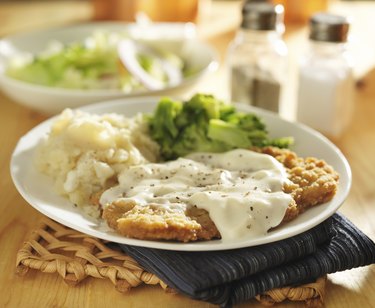
Many dieters sigh over their inability to resist chocolate, licorice or their favorite cake. For real, over-the-top addictiveness, though, nothing matches deep frying. The smell of golden french fries or battered fish coming from a nearby restaurant is as alluring as anything could be. Fortunately, deep frying leaves little oil on the food when it's done right with a good, hot fryer and a well-made batter.
The Role of Batter
Video of the Day
Deep-frying is a fast cooking method, one that heats foods abruptly. Fat is much more efficient at transferring heat than air is, so the same french fries that need 20 minutes in your oven might only need three or four in the fryer. Most foods need some protection from that intensity, so they're battered or breaded before frying. Battering food helps retain moisture, keeping it from drying out and toughening in the hot fat. By keeping the juices in your food, batter also protects the oil from contamination and premature breakdown. Batter also produces a crisp, golden, flavorful crust.
Video of the Day
Making Batter
Making basic batter is simple. It consists of a starch, usually wheat flour, and a liquid. The liquid can be water, milk, beer, eggs or any combination that appeals to the cook. Most batters add baking powder to make them lighter, or a combination of baking soda and an acidic ingredient such as buttermilk. Batters made with beer or soda water are leavened by the carbonation in the liquid. Eggs, dairy ingredients, sugar, turmeric or paprika an all help the batter develop a richer golden-brown color. Batter should be light, crisp and not taste of oil.
Batter With Milk
Thin liquids such as water, beer and soda water make the lightest batters, but milk isn't far behind. Milk-based batter should be mixed to a consistency thinner than pancake batter but thicker than heavy cream, and then ideally chilled for an hour before it's used. The proteins in milk help the batter adhere to your food, while the natural sugars and milk solids provide extra browning. If the batter is mixed to the correct consistency and fried at a suitable temperature, milk-based batter provides a thin, crisp coating with a beautiful golden hue.
Batter with Eggs
Eggs are made up of several components, from the proteins in the whites to the fats and emulsifiers in the yolks. When you add eggs to your batter, the yolks give it a pale golden color and soften the flour's gluten strands slightly, giving the crust a more delicate crispness. The eggs' proteins help the flour form a better moisture seal, keeping your food moister, and they also reduce the batter's ability to absorb oil. However, eggs also make the batter heavier, and if you aren't careful to thin it to the right consistency, the finished batter can be unpleasantly doughy inside.